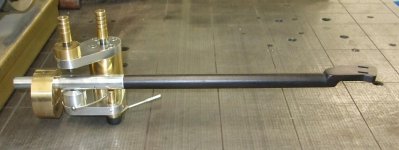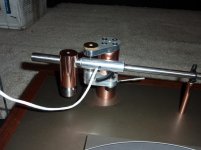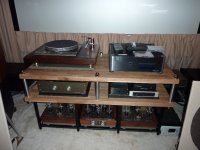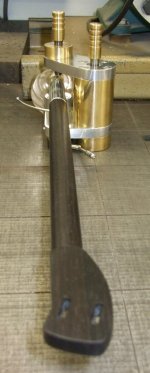HI JD great work !
can be to much wire that arm drag on ?
absolutely no drag... the outer cover is a very fine silk weave, virtually less than the weight of a feather and the wire itself is four strands of Van Den Hul MCS150 Silver which also is exceptionally light and very very flexible...Also the wire is teathered at the back of the plinth so there is no drag.
End result is that there is no real resisance to interfere with the free rotation/sweep of the arm.
JD
Hi Jeffrey,
If you find that the arm has a tendency to "flip" to either side(left or right, as seen from the front) , when the gap is set to a distance < x, you have four options:
a.
Lower the center of gravity of the "suspended" part, i.e. by using a counterweight with a more pronounced offset(Not practical in your case, since you already have an elaborate cw)
b.
Decrease the effective diameter/surface of the lower magnet by, i.e, giving the top a spherical shape(rounding off the circumference might suffice). This will affect the behaviour of the bearing in a possibly undesirable way: The tracking force will increase more rapidly when increasing VTA(and vice versa).
c.
Round off just the left/right edges of the top magnet(you will need a diamond grinding disc + liquid cooling, removing the magnetic dust is a pita, replating or other type of antioxidation treatment recommended). This will increase stability along the longitudinal(armwand) axis without changing the current VTA to VTF alteration rate.
d.
Use a thicker pole piece. This lowers the total cog(see a.), changes the behaviour of the bearing(towards increased stability) and has the same effect as b.
I hope this helps 🙂
And since I was in France to attend the European Triode Festival I couldn't answer sooner, sorry...
Cheers,
Frank
If you find that the arm has a tendency to "flip" to either side(left or right, as seen from the front) , when the gap is set to a distance < x, you have four options:
a.
Lower the center of gravity of the "suspended" part, i.e. by using a counterweight with a more pronounced offset(Not practical in your case, since you already have an elaborate cw)
b.
Decrease the effective diameter/surface of the lower magnet by, i.e, giving the top a spherical shape(rounding off the circumference might suffice). This will affect the behaviour of the bearing in a possibly undesirable way: The tracking force will increase more rapidly when increasing VTA(and vice versa).
c.
Round off just the left/right edges of the top magnet(you will need a diamond grinding disc + liquid cooling, removing the magnetic dust is a pita, replating or other type of antioxidation treatment recommended). This will increase stability along the longitudinal(armwand) axis without changing the current VTA to VTF alteration rate.
d.
Use a thicker pole piece. This lowers the total cog(see a.), changes the behaviour of the bearing(towards increased stability) and has the same effect as b.
I hope this helps 🙂
And since I was in France to attend the European Triode Festival I couldn't answer sooner, sorry...
Cheers,
Frank
Last edited:
Ahh,
I forgot to comment on the silicon damping fluid option. Feel free to experiment, but I have found it to be useful in only two cases. Grados and vintage Deccas(possibly Ikedas as well). All other carts(incl. Benz Ruby, which is polite sounding to begin with) will exhibit a slight decrease in top end extension and dynamics if any more than the tiniest drop of said viscosity silicon fluid is used. Bass tightness will increase if your gap is set fairly wide(>1mm).
Cheers,
Frank
I forgot to comment on the silicon damping fluid option. Feel free to experiment, but I have found it to be useful in only two cases. Grados and vintage Deccas(possibly Ikedas as well). All other carts(incl. Benz Ruby, which is polite sounding to begin with) will exhibit a slight decrease in top end extension and dynamics if any more than the tiniest drop of said viscosity silicon fluid is used. Bass tightness will increase if your gap is set fairly wide(>1mm).
Cheers,
Frank
Thanks Frank as always! Good information. I'm more or less, locked into the magnets and their pole piece dimensions as all is assembled/and press fitted, so disassembly would be just a bit inconvenient.
The one item that I can readily play with is the counterweight. No problem with shelving (i.e. put back on the shelf) the current "GrooveTracer" part.
I have some thoughts on how to lower the COG in a self built part. I'll use a 1" or so diameter cylinder about 2" long and bore out the armtube stub hole so that the length of the cylinder hangs down below and perpendicular to the armwand. It will have a Delrin bushing for decoupling and a nylon tipped setsrew to secure it in position. This should give a counterweight of about 180 to 190 grams which is my target.... and at only about $6.00 for the raw material, I'm not out much pocket change.
The "flopping" is not really that bad as the top of the hole in the armtube never touches the string on either side of the "flop". I have it somewhat stabilized close to the center with carefull adjustment of the current counterweight. and the magnets never touch on either side of the "flop" as well, even with the magnets fairly close to each other. I have no trouble with adjustment of azimuth as I designed the headshell side of the tonearm to be able to be rotated as needed.
Also thanks for the note on the damping fluid...Since I already filled the well, I'll listen to it for while that way, then remove it later to see which sounds better.... this will have to be after the cartridge breaks in to better determine this.
Again Frank, I cant thank you enough for the help you've give here and to the others.
b.t.w. I saw some pics of your "little" arm at the event with you huddled over it...amazing what you'll find on the WWW 🙂
http://www.holgerbarske.com/etf09/album/hb/slides/DSC_0210.html
Jeff
The one item that I can readily play with is the counterweight. No problem with shelving (i.e. put back on the shelf) the current "GrooveTracer" part.
I have some thoughts on how to lower the COG in a self built part. I'll use a 1" or so diameter cylinder about 2" long and bore out the armtube stub hole so that the length of the cylinder hangs down below and perpendicular to the armwand. It will have a Delrin bushing for decoupling and a nylon tipped setsrew to secure it in position. This should give a counterweight of about 180 to 190 grams which is my target.... and at only about $6.00 for the raw material, I'm not out much pocket change.
The "flopping" is not really that bad as the top of the hole in the armtube never touches the string on either side of the "flop". I have it somewhat stabilized close to the center with carefull adjustment of the current counterweight. and the magnets never touch on either side of the "flop" as well, even with the magnets fairly close to each other. I have no trouble with adjustment of azimuth as I designed the headshell side of the tonearm to be able to be rotated as needed.
Also thanks for the note on the damping fluid...Since I already filled the well, I'll listen to it for while that way, then remove it later to see which sounds better.... this will have to be after the cartridge breaks in to better determine this.
Again Frank, I cant thank you enough for the help you've give here and to the others.
b.t.w. I saw some pics of your "little" arm at the event with you huddled over it...amazing what you'll find on the WWW 🙂
http://www.holgerbarske.com/etf09/album/hb/slides/DSC_0210.html
Jeff
Last edited:
Hey guys! how'd we let this thread get to the 2nd page???
Anyways... Here's new pic of my arm. I'm still learning the in's and outs of my new camera.
Frank.... took your advice and changed up the counterweight so the CG sits much lower.
I also incresed the weight from 170g to 240g to be able to bring it closer to the pivot point.
This definately aliviates the flop left/ flop right problem of the out-rigger system I was using before. Tracking force is set for 2g and it measures constant across the entire surface of the record.
Monday I will bring it from my workbench and put it into service in my system.
Anyways... Here's new pic of my arm. I'm still learning the in's and outs of my new camera.
Frank.... took your advice and changed up the counterweight so the CG sits much lower.
I also incresed the weight from 170g to 240g to be able to bring it closer to the pivot point.
This definately aliviates the flop left/ flop right problem of the out-rigger system I was using before. Tracking force is set for 2g and it measures constant across the entire surface of the record.
Monday I will bring it from my workbench and put it into service in my system.
Attachments
Last edited:
very nice!
I have a nice air dried piece of Ebony that I was going to use, but I don't have accsess to a lathe nor do I know of any woodworkers local and outsourcing was not being fruitfull, and I did spend a lot of time looking. Instead, I went with a Titanium outer armtube with an inner carbon fiber tube suspended with internal damping "O" rings .
I realy like the look of Ebony.
Jeff
I have a nice air dried piece of Ebony that I was going to use, but I don't have accsess to a lathe nor do I know of any woodworkers local and outsourcing was not being fruitfull, and I did spend a lot of time looking. Instead, I went with a Titanium outer armtube with an inner carbon fiber tube suspended with internal damping "O" rings .
I realy like the look of Ebony.
Jeff
Got my ebony wand wand finished, so just wireing, suspension thread and magnets to fit, should be up and running very soon.
Couple more shots...
Man oh man... even unbroken in the sound is in a league way way above the old DL103R.......
I can never thank Frank enough for the help.
Jeff Davison
Man oh man... even unbroken in the sound is in a league way way above the old DL103R.......
I can never thank Frank enough for the help.
Jeff Davison
Attachments
Last edited:
Rega replacement part, availale at just about any Rega dealer, Mune cost $60 USD
JD
JD
How you made Ton-Arm lift?
Regards zeoN_Rider
ebony wand
Thanks,
I did try to out source the wand, but thought i would have a go myself, it was much easier than i expected, i used macasser ebony AAA grade, not as brittle as the African ebony. The hardest part was cutting the slots for the cartridge.
At the moment having trouble sourcing some suitable suspension thread, was going to use Kevlar, but can only source the spun variety, not the filiment stuff, plus unsure what thickness to get.
Anyone know if the spun kevlar is strong enough?
or any alternatives?
Thanks.
Thanks,
I did try to out source the wand, but thought i would have a go myself, it was much easier than i expected, i used macasser ebony AAA grade, not as brittle as the African ebony. The hardest part was cutting the slots for the cartridge.
At the moment having trouble sourcing some suitable suspension thread, was going to use Kevlar, but can only source the spun variety, not the filiment stuff, plus unsure what thickness to get.
Anyone know if the spun kevlar is strong enough?
or any alternatives?
Thanks.
Attachments
I'm using "Vectran" in my arm. It's a multi fiber thread, supposedly stronger than Kevlar. It's used in mountaineering ropes and astronauts space suits. It also has less stretch than Kevlar.
It's a bit tricky to handle because of all the thin fibers bundle. They have habit of separating when trying to thread small hole. The method I discovered was to tightly twist a segment, compressing the fibers at a section, and put a very small drop of "Super Glue" (Cyanoacrylic adhesive) on that spot and wait until it sets hard... about a minute. You can cut it at that point with a very sharp hobby knife (X-Acto), and if you've twisted it tightly enough before the SuperGlue application, you have a thin hard section that you can indeed thread that small hole and pull a length through then tie your knot. I had to tie three knots as one knot is small enough to come back through the hole if you pull it.
After I made the 3 knots, I then put another drop of super glue on the bundle. I did this on the upper set (grub) screw ( I had enough depth as to not interfere with the insertion of the hex wrench. I did the same for the bottom disc as well. It was dimpled in the center with a through hole. The knot bundle sat flush on the underside in the dimpled cavity.
It would behoove you to practice and develop a technique using extra grub screws and discs and thread to get the right length you need when finished, and to feel comfortable handlin them
.
I got my Vectran from an eBay vendor. about $5 USD or so for 50 feet.. plenty to practice with.
Jeff
It's a bit tricky to handle because of all the thin fibers bundle. They have habit of separating when trying to thread small hole. The method I discovered was to tightly twist a segment, compressing the fibers at a section, and put a very small drop of "Super Glue" (Cyanoacrylic adhesive) on that spot and wait until it sets hard... about a minute. You can cut it at that point with a very sharp hobby knife (X-Acto), and if you've twisted it tightly enough before the SuperGlue application, you have a thin hard section that you can indeed thread that small hole and pull a length through then tie your knot. I had to tie three knots as one knot is small enough to come back through the hole if you pull it.
After I made the 3 knots, I then put another drop of super glue on the bundle. I did this on the upper set (grub) screw ( I had enough depth as to not interfere with the insertion of the hex wrench. I did the same for the bottom disc as well. It was dimpled in the center with a through hole. The knot bundle sat flush on the underside in the dimpled cavity.
It would behoove you to practice and develop a technique using extra grub screws and discs and thread to get the right length you need when finished, and to feel comfortable handlin them
.
I got my Vectran from an eBay vendor. about $5 USD or so for 50 feet.. plenty to practice with.
Jeff
Thanks,
I did try to out source the wand, but thought i would have a go myself, it was much easier than i expected, i used macasser ebony AAA grade, not as brittle as the African ebony. The hardest part was cutting the slots for the cartridge.
At the moment having trouble sourcing some suitable suspension thread, was going to use Kevlar, but can only source the spun variety, not the filiment stuff, plus unsure what thickness to get.
Anyone know if the spun kevlar is strong enough?
or any alternatives?
Thanks.
Last edited:
> I got my Vectran from an eBay vendor. about $5 USD or so for 50 feet.. plenty to practice with.
Would you be kind enought o consider selling me 5 ft ?
How much would you want including post (air mail to Europe) in an envelope ?
Many thanks in any case for sharing your experience.
BR,
Patrick
Would you be kind enought o consider selling me 5 ft ?
How much would you want including post (air mail to Europe) in an envelope ?
Many thanks in any case for sharing your experience.
BR,
Patrick
Last edited:
Probably just as easy to get it direct.
Here's a link to the eBay seller.. he's always selling it:
100 Feet Vectran yarn, thread, STRONGER than Kevlar - eBay (item 360117040779 end time Jan-10-10 09:15:51 PST)
Here's a link to the eBay seller.. he's always selling it:
100 Feet Vectran yarn, thread, STRONGER than Kevlar - eBay (item 360117040779 end time Jan-10-10 09:15:51 PST)
> I got my Vectran from an eBay vendor. about $5 USD or so for 50 feet.. plenty to practice with.
Would you be kind enought o consider selling me 5 ft ?
How much would you want including post (air mail to Europe) in an envelope ?
Many thanks in any case for sharing your experience.
BR,
Patrick
Thanks for the link.
He only ships to US and Canada, unfortunately. 🙁
And shipment from US by commercial sellers is usually more expensive than the item itself (because they want to minimise their administrative work and use Fedex or UPS or whatever else), which was why I asked in the first place.
Patrick
He only ships to US and Canada, unfortunately. 🙁
And shipment from US by commercial sellers is usually more expensive than the item itself (because they want to minimise their administrative work and use Fedex or UPS or whatever else), which was why I asked in the first place.
Patrick
only costs an email to find out.
Let us know.
JD
Let us know.
JD
If the seller is willing to do so, yes.
Patrick
- Home
- Source & Line
- Analogue Source
- DIY Schroeder Tonearm?






